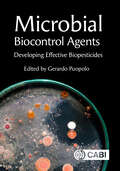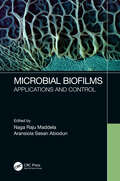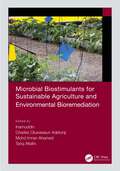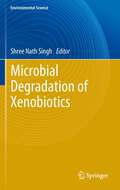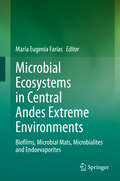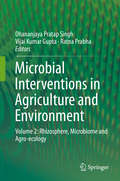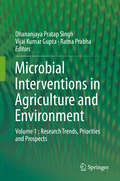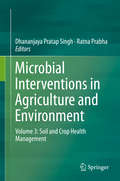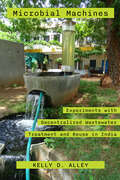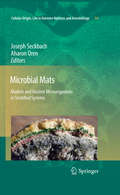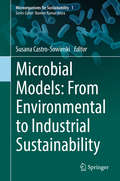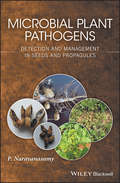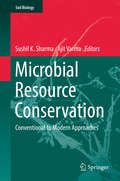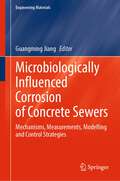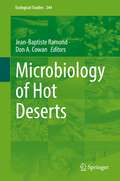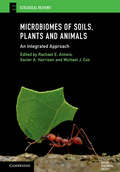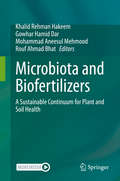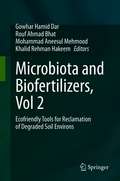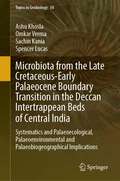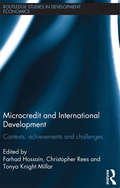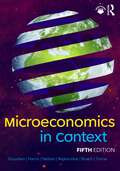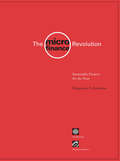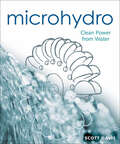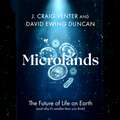- Table View
- List View
Microbial Biocontrol Agents: Developing Effective Biopesticides
by Abhishek Anand Marc Bardin Ana Bejarano Elisa Bona Tito Caffi Hamza Chammem Antonieta De Cal Margherita Furiosi Elisa Gamalero Bernard R. Glick Belén Guijarro Lars Huber Dr Ajay Kumar Inmaculada Larena Sara E. Legler Carla S. Lorenz Paloma Melgarejo Hassan Momeni Fahimeh Nazari Andrea Nesler Philippe Nicot Ma. del Orozco-Mosquedab Ilaria Pertot Thomas Pressecq Dr Gerardo Puopolo Vittorio Rossi Naser Safaie Gustavo Santoyo Selena Tomada Estelle Turc Maria Villarino Mout De Vrieze Laure WeisskopfThe negative impact of chemical pesticides on human wellbeing and the environment has encouraged the development of eco-friendly alternatives for the management of plant pathogens. However, only a small number of microbial biocontrol agents (mBCAs) have been developed, registered and used in the management of plant diseases. This book analyses the deployment of mBCAs for the development of novel microbial biopesticides, considering the main plant-beneficial traits, procedures needed for effective formulations and the processes used for their validation. To guide the readers through the world of microbial biopesticides, the book starts with a chapter dedicated to the regulations that need to be followed for the development of final products. Readers will understand the importance of formulation and mode of action of mBCAs in developing microbial biopesticides. They will become familiar with key mBCAs such as Ampelomyces quisqualis, Bacillus spp., Trichoderma spp., and Pseudomonas spp., understanding the importance of formulation for their application in the field. This book explains the use of mBCAs to control post-harvest diseases and the potential of endophytic microorganisms as next-generation microbial biopesticides. A final chapter provides a useful workflow for the selection of new mBCAs and describes microbial species including promising mBCAs that might be developed as new microbial biopesticides. - Gives useful insights into the practicalities of regulation of mBCAs - Describes the underlying biology that it is critical to developing mBCAs - Provides case studies for key mBCA species - Indicates microbial species exploitable for the development of new microbial biopesticides For students and researchers involved in crop protection and biological control
Microbial Biofilms: Applications and Control
by Naga Raju Maddela Aransiola Sesan AbiodunMicrobial biofilms have both positive and negative effects. This book considers new ways of controlling environmental microbial biofilm such as using phages, nanotechnology, and newly discovered microbial enzymes. A team of contributors shares current, relevant and original research to add weight and recognition to the book. Also, each chapter provides enlightening and relevant tabular information, charts, and illustrations. The book is, therefore, informative, precise, useful and easily digested by users.
Microbial Biostimulants for Sustainable Agriculture and Environmental Bioremediation
by InamuddinToday, the agriculture industry is confronted with simultaneous issues of how to fully embrace mass production of safer food in terms of both quality and quantity. Most industries are concerned with avoiding significant levels of soil pollution and environmental threats as a result of the excessive and harmful use of synthetic products on crops. Therefore, there is a need to adopt sustainable technological innovations that can ensure the sustainability of agricultural production systems.Microbial Biostimulants for Sustainable Agriculture and Environmental Bioremediation discusses the benefits, challenges, and practical applications of eco-friendly biotechnological techniques using biostimulants derived from beneficial microorganisms. The chapters cover the use of these organisms to increase crop production, enhance soil fertility and maintain soil health, create crop and plant tolerance to different abiotic stressors, release required nutrients to the soil, increase resistance to plant pathogens/pests, improve nutrient use efficiency of crops, and rejuvenate polluted environments.FEATURES Explores the physiological, morpho-anatomical, and biochemical molecular plant rejoinders involved in stimulating crop productivity Provides information on the physiological, cellular, and molecular modes of action underlying microbial biostimulant interfaces Summarizes methods and approaches for executing microbial stimulant technology Outlines numerous environmental management and remediation strategies This book is an ideal resource for researchers, engineers, and academics working in soil science, crop science, water remediation, microbiology, and biotechnology.
Microbial Degradation of Xenobiotics
by Shree Nath SinghOur interest in the microbial biodegradation of xenobiotics has increased many folds in recent years to find out sustainable ways for environmental cleanup. Bioremediation and biotransformation processes harness the naturally occurring ability of microbes to degrade, transform or accumulate a wide range of organic pollutants. Major methodological breakthroughs in recent years through detailed genomic, metagenomic, proteomic, bioinformatic and other high-throughput analyses of environmentally relevant microorganisms have provided us unprecedented insights into key biodegradative pathways and the ability of organisms to adapt to changing environmental conditions. The degradation of a wide spectrum of organic pollutants and wastes discharged into the environment by anthropogenic activities is an emerging need today to promote sustainable development of our society with low environmental impact. Microbial processes play a major role in the removal of recalcitrant compounds taking advantage of the astonishing catabolic versatility of microorganisms to degrade or transform such compounds. New breakthroughs in sequencing, genomics, proteomics, bioinformatics and imaging are generating vital information which opens a new era providing new insights of metabolic and regulatory networks, as well as clues to the evolution of degradation pathways and to the molecular adaptation strategies to changing environmental conditions. Functional genomic and metagenomic approaches are increasing our understanding of the relative importance of different pathways and regulatory networks to carbon flux in particular environments and for particular compounds. New approaches will certainly accelerate the development of bioremediation technologies and biotransformation processes in coming years for natural attenuation of contaminated environments
Microbial Ecosystems in Central Andes Extreme Environments: Biofilms, Microbial Mats, Microbialites and Endoevaporites
by María Eugenia FaríasThe Central Andean Altiplane represents a unique extreme environment due to its high altitude, closed basins that modulate the salt pans and saline wetlands surrounded by deserts, as well as the considerable influence of volcanic activity. UV radiation, arsenic content, high salinity, alkalinity and low dissolved oxygen levels, together with extreme daily temperature fluctuations and oligotrophic conditions, shape an environment that resembles the early Earth and, even more, extraterrestrial conditions. By developing simple biofilms stratified microbial mats or complex microbialites, extreme microbial ecosystems, colonize and thrived in different environments like salt flats, wetlands, lakes volcano vents, geysers and deserts. This book presents our current understanding of these amazing ecosystems, providing a basis for their protection and sustainable utilization. The main audience for this book included researchers and graduate students as well as professionals working in the government, mining industry and similar activities.
Microbial Interventions in Agriculture and Environment: Volume 2: Rhizosphere, Microbiome and Agro-ecology
by Dhananjaya Pratap Singh Vijai Kumar Gupta Ratna PrabhaMicrobial communities and their functions play a crucial role in the management of ecological, environmental and agricultural health on the Earth. Microorganisms are the key identified players for plant growth promotion, plant immunization, disease suppression, induced resistance and tolerance against stresses as the indicative parameters of improved crop productivity and sustainable soil health. Beneficial belowground microbial interactions with the rhizosphere help plants mitigate drought and salinity stresses and alleviate water stresses under the unfavorable environmental conditions in the native soils. Microorganisms that are inhabitants of such environmental conditions have potential solutions for them. There are potential microbial communities that can degrade xenobiotic compounds, pesticides and toxic industrial chemicals and help remediate even heavy metals, and thus they find enormous applications in environmental remediation. Microbes have developed intrinsic metabolic capabilities with specific metabolic networks while inhabiting under specific conditions for many generations and, so play a crucial role. The book Microbial Interventions in Agriculture and Environment is an effort to compile and present a great volume of authentic, high-quality, socially-viable, practical and implementable research and technological work on microbial implications. The whole content of the volume covers protocols, methodologies, applications, interactions, role and impact of research and development aspects on microbial interventions and technological outcomes in prospects of agricultural and environmental domain including crop production, plan-soil health management, food & nutrition, nutrient recycling, land reclamation, clean water systems and agro-waste management, biodegradation & bioremediation, biomass to bioenergy, sanitation and rural livelihood security. The covered topics and sub-topics of the microbial domain have high implications for the targeted and wide readership of researchers, students, faculty and scientists working on these areas along with the agri-activists, policymakers, environmentalists, advisors etc. in the Government, industries and non-government level for reference and knowledge generation.
Microbial Interventions in Agriculture and Environment: Volume 1 : Research Trends, Priorities and Prospects
by Dhananjaya Pratap Singh Vijai Kumar Gupta Ratna PrabhaMicrobial communities and their functions play a crucial role in the management of ecological, environmental and agricultural health on the Earth. Microorganisms are the key identified players for plant growth promotion, plant immunization, disease suppression, induced resistance and tolerance against stresses as the indicative parameters of improved crop productivity and sustainable soil health. Beneficial belowground microbial interactions with the rhizosphere help plants mitigate drought and salinity stresses and alleviate water stresses under the unfavorable environmental conditions in the native soils. Microorganisms that are inhabitants of such environmental conditions have potential solutions for them. There are potential microbial communities that can degrade xenobiotic compounds, pesticides and toxic industrial chemicals and help remediate even heavy metals, and thus they find enormous applications in environmental remediation. Microbes have developed intrinsic metabolic capabilities with specific metabolic networks while inhabiting under specific conditions for many generations and, so play a crucial role. The book Microbial Interventions in Agriculture and Environment is an effort to compile and present a great volume of authentic, high-quality, socially-viable, practical and implementable research and technological work on microbial implications. The whole content of the volume covers protocols, methodologies, applications, interactions, role and impact of research and development aspects on microbial interventions and technological outcomes in prospects of agricultural and environmental domain including crop production, plan-soil health management, food & nutrition, nutrient recycling, land reclamation, clean water systems and agro-waste management, biodegradation & bioremediation, biomass to bioenergy, sanitation and rural livelihood security. The covered topics and sub-topics of the microbial domain have high implications for the targeted and wide readership of researchers, students, faculty and scientists working on these areas along with the agri-activists, policymakers, environmentalists, advisors etc. in the Government, industries and non-government level for reference and knowledge generation.
Microbial Interventions in Agriculture and Environment: Volume 3: Soil and Crop Health Management
by Dhananjaya Pratap Singh Ratna PrabhaMicrobial communities and their multi-functionalities play a crucial role in the management of soil and plant health, and thus help in managing agro-ecology, the environment and agriculture. Microorganisms are key players in N-fixation, nutrient acquisition, carbon sequestration, plant growth promotion, pathogen suppression, induced systemic resistance and tolerance against stresses, and these parameters are used as indicators of improved crop productivity and sustainable soil health. Beneficial belowground microbial interactions in the rhizosphere help plants combat abiotic challenges in the unfavourable environmental conditions of native soils. These microorganisms and their products offer potential solutions for agriculture in problematic areas since they are able to degrade xenobiotic compounds, pesticides and toxic chemicals and help remediate heavy metals in the rhizosphere and so make deteriorated soils suitable for crop production. This book compiles the latest research on the role of microbes in the rhizosphere and agro-ecology, covering interaction mechanisms, microbe-mediated crop production, plant and soil health management, food and nutrition, nutrient recycling, land reclamation, clean water systems, agro-waste management, biodegradation, bioremediation, biomass and bioenergy, sanitation and rural livelihood security. It is a comprehensive reference resource for agricultural activists, policymakers, environmentalists and advisors working for governments, non-governmental organizations and industries, helping them update their knowledge of this important, but often neglected, research area.
Microbial Machines: Experiments with Decentralized Wastewater Treatment and Reuse in India
by Kelly D. AlleyAround 2004, members of governmental and nongovernmental organizations, science institutes, and private companies throughout India began brainstorming and then experimenting with small-scale treatment systems that could produce usable water from wastewater. Through detailed case studies, Microbial Machines describes how residents, workers, and scientists interact with technology, science, and engineering during the processes of treatment and reuse. Using a human-machine-microbe framework, Kelly Alley explores the ways that people's sensory perceptions of water—including disgust—are dynamic and how people use machines and microbes to digest wastewater. A better understanding of how the human and nonhuman interact in these processes will enable people to generate more effective methods for treating and reusing wastewater. While decentralized wastewater treatment systems may not be a perfect solution, they alleviate resource stress in regions that are particularly hard hit by climate change. These case studies have broad relevance for solving similar problems in many other places around the world.
Microbial Mats
by Aharon Oren Joseph SeckbachThis book provides information about microbial mats, from early fossils to modern mats located in marine and terrestrial environments. Microbial mats - layered biofilms containing different types of cells - are most complex systems in which representatives of various groups of organisms are found together. Among them are cyanobacteria and eukaryotic phototrophs, aerobic heterotrophic and chemoautotrophic bacteria, protozoa, anoxygenic photosynthetic bacteria, and other types of microorganisms. These mats are perfect models for biogeochemical processes, such as the cycles of chemical elements, in which a variety of microorganisms cooperate and interact in complex ways. They are often found under extreme conditions and their study contributes to our understanding of extremophilic life. Moreover, microbial mats are models for Precambrian stromatolites; the study of modern microbial mats may provide information on the processes that may have occurred on Earth when prokaryotic life began to spread.
Microbial Models: From Environmental to Industrial Sustainability
by Susana Castro-SowinskiThis book describes selected microbial genera from the perspective of their environmentally and commercially sustainable use. By focusing on their physiology and metabolism and combining historical information with the latest developments, it presents a multidisciplinary portrait of microbial sustainability. The chapters provide readers descriptions of each genus in the form of microbial models that move us closer to the goal of sustainability; selected chapters also include worldwide market information and lists of corresponding patents.
Microbial Plant Pathogens: Detection and Management in Seeds and Propagules
by Perumal NarayanasamyHealthy seeds and propagules are the basic requirement for producing good grains, fruits and vegetables needed for human survival and perpetuation. Dispersal of microbial plant pathogens via seeds and propagules has assumed more importance than other modes of dispersal, as infected seeds and propagules have the potential to become the primary sources of carrying pathogen inoculum for subsequent crops. Several diseases transmitted through seeds and propagules have been shown to have the potential to damage economies as a result of huge quantitative and qualitative losses in numerous crops. Hence, it is essential to rapidly detect, identify and differentiate the microbial plant pathogens present in seeds and propagules precisely and reliably, using sensitive techniques. Microbial Plant Pathogens: Detection and Management in Seeds and Propagules provides a comprehensive resource on seed-borne and propagule-borne pathogens. Information on the biology of microbial pathogens, including genetic diversity, infection process and survival mechanisms of pathogens and epidemiology of diseases caused by them, are discussed critically and in detail to highlight weak links in the life cycles of the pathogens.Development of effective disease management systems, based on the principles of exclusion and eradication of pathogens and immunization of crop plants to enhance the levels of resistance of cultivars to diseases, has been effective to keep the pathogens at bay. The need for production of disease-free seeds/propagules has been emphasized to prevent the carryover of the inoculum to the next crop or introduction of the pathogens to other locations. Effectiveness of adopting simple cultural practices and development of cultivars resistant to diseases through traditional breeding methods or biotechnological approach have resulted in reducing the pathogen inoculum and disease incidence. Although application of different chemicals may reduce the disease incidence effectively, biological management of crop diseases, employing potential biological control agents have to be preferred to preserve the agroecosystems. Greater efforts have to be made to integrate compatible strategies to enhance the effectiveness of diseases management systems. Protocols appended at the end of relevant chapters form a unique feature of this book to enable the researchers to fine-tune their projects. This 2 volume set provides comprehensive and updated information about the economically-important groups of microbial plant pathogens carried by seed and propagules. Graduate students, researchers and teachers of plant pathology, plant protection, microbiology, plant breeding and genetics, agriculture and horticulture, as well as certification and quarantine personnel will find the information presented in this book useful.
Microbial Resource Conservation: Conventional to Modern Approaches (Soil Biology #54)
by Sushil K. Sharma Ajit VarmaThis book covers broad areas in the conservation of microorganisms. It addresses the short, medium and long-term preservation of agriculturally important microorganisms, as well as culture collections and their roles. The respective chapters address topics such as conventional approaches to bacterial, fungal and algal preservation, as well as methods and strategies for preserving recalcitrant microorganisms. Readers will also find the latest insights into the preservation of vesicular-arbuscular (VA) fungi and ecology, diversity and conservation of endophytes, and entamopathogenic fungi. Microbes of animal and dairy origin, their preservation and biosafety issues are also explored. Microorganisms are the silent and unseen majority of life on Earth, and are characterized by a high degree of genetic and metabolic diversity. It is well documented that no branch of science or society is unaffected by microbial interventions. Researchers have documented microorganisms from such extreme and unique environments as deserts and hydrothermal vents, and with specific traits that are currently being exploited in agriculture, industry, medicine and biotechnological applications. Such great potential can only be found in microorganisms. The aim of this book – the first entirely devoted to the conservation of microorganisms, and to regulatory mechanisms for access and benefits sharing as per Biological Diversity (BD) Act 2002 – is to promote awareness of our world’s microbial wealth, and to introduce readers to strategies and methodologies for the conservation of microorganisms, which could ultimately save human life on Earth.
Microbiologically Influenced Corrosion of Concrete Sewers: Mechanisms, Measurements, Modelling and Control Strategies (Engineering Materials)
by Guangming JiangThis book is a unique resource for professionals seeking a comprehensive understanding of microbiologically influenced corrosion in concrete sewers (MICC), which play a critical role in modern urban infrastructure. Corrosion can lead to structural collapse and significant financial losses due to the costly rehabilitation and replacement of damaged sewer systems. In the United States alone, sewer asset losses attributed to corrosion are estimated to reach $14 billion annually.The book provides a cross-disciplinary approach to understanding the physical, chemical, and biological processes that contribute to microbiologically influenced concrete corrosion. Readers will learn about corrosion rate measurement and characterization methods, controlling environmental factors, corrosion prediction models, and mitigation and control strategies. The book also covers the development of corrosion-resistant concrete. Written for civil engineers, environmental engineers, concrete technologists, and sewer operators and managers, this book is both informative and practical. It not only provides fundamental knowledge of the development of corrosion but also offers practical solutions that are economically and environmentally sustainable. By collating a range of corrosion analytics and control measures, this book is an essential reference for anyone seeking to prevent and manage concrete corrosion in sewer systems.
Microbiology of Hot Deserts (Ecological Studies #244)
by Jean-Baptiste Ramond Don A. CowanThis book covers the wider aspects of the microbiology of hot desert soil ecosystems, compiling disparate information from a range of relevant desert soil microbial fields.The reader learns about microbial ecology of the more dominant and possibly most important desert habitats, detailing the phylogenetic and functional diversity of these different habitats as well as their potential role in desert ecosystem ecology. Particular attention is also given to microbial stress adaptation in hot desert soils. Furthermore, it is the first volume in this particular field to cover modern metagenomics technologies that can be applied to studies of all aspects of desert microbial communities. Additionally, the book explores viruses and viral communities, which are among the least studied (and little understood) components of desert soil microbial communities. Particular attention is also given to the roles of desert microbial communities in biogeochemical cycling of carbon, nitrogen and phosphorus. Through this book the reader discovers how desert microbiology has been at the forefront of Astrobiology and how it may be used conceptually in future terraforming strategies. Desert ecosystems are increasingly coming into focus given the impacts of climate change and desertification trends, making this volume particularly timely. Each of the chapters is authored by leading international researchers and is a must-read for microbial ecologists.
Microbiomes of Soils, Plants and Animals: An Integrated Approach (Ecological Reviews)
by Rachael E. Antwis Xavier A. Harrison Michael J. CoxThrough a long history of co-evolution, multicellular organisms form a complex of host cells plus many associated microorganism species. Consisting of algae, bacteria, archaea, fungi, protists and viruses, and collectively referred to as the microbiome, these microorganisms contribute to a range of important functions in their hosts, from nutrition, to behaviour and disease susceptibility. In this book, a diverse and international group of active researchers outline how multicellular organisms have become reliant on their microbiomes to function, and explore this vital interdependence across the breadth of soil, plant, animal and human hosts. They draw parallels and contrasts across hosts in different environments, and discuss how this invisible microbial ecosystem influences everything from the food we eat, to our health, to the correct functioning of ecosystems we depend on. This insightful read also pertinently encourages students and researchers in microbial ecology, ecology, and microbiology to consider how this interdependence may be key to mitigating environmental changes and developing microbial biotechnology to improve life on Earth.
Microbiota and Biofertilizers: A Sustainable Continuum for Plant and Soil Health
by Khalid Rehman Hakeem Gowhar Hamid Dar Mohammad Aneesul Mehmood Rouf Ahmad BhatAn increasing population has put tremendous pressure on agricultural productivity to fulfill the demands of human consumption. Numerous agricultural activities and techniques have been developed to raise annual crop production globally. While agriculture has succeeded in enhancing the yearly crop productivity, this achievement is at the cost of environmental degradation by applying synthetic persistent substances, such as industrial fertilizers, pesticides, herbicides, etc. Chemical fertilizers are nearly as destructive as they are productive, causing monocultures and consequences associated with elimination of diversity, nutrient pollution as evidenced by algae blooms, eutrophication, water quality issues, lower oxygen levels and dangers to fish stocks. Therefore, the scientific approach to maintain sustainable fertility in soil and plants is to switch over to biofertilisers.Biofertilisers are compounds of organic matter that are applied to crops for growth and health. Their constituent micro-organisms interact in an ecofriendly manner with the soil, root and seeds of plants, promoting the growth of micro-flora that enhances soil fertility. They are known to play a number of vital roles in soil fertility, crop productivity and production in agriculture. Application of biofertilisers results in increased mineral and water uptake, root development, vegetative growth and nitrogen fixation. They liberate growth promoting substances and vitamins and help to maintain soil fertility. They act as antagonists and play a pivotal role in neutralising the soil borne plant pathogens, thereby assisting in the bio-control of diseases. Application of biofertilisers in lieu of synthetic fertilizers could be the promising technique to raise agricultural productivity without degrading the environmental quality. The present book focuses on the latest research approaches and updates from the microbiota ecosystem and their applications in agriculture industry. It also highlights the great potential and possible future of action of microbiota in the development of sustainable agricultural systems.
Microbiota and Biofertilizers, Vol 2: Ecofriendly Tools for Reclamation of Degraded Soil Environs
by Gowhar Hamid Dar Rouf Ahmad Bhat Mohammad Aneesul Mehmood Khalid Rehman HakeemThe dependence of present farming on artificial input of “chemical fertilizers” has caused numerous ecological tribulations associated with global warming and soil contamination. Moreover, there is an essential requirement for realistic agricultural practices on a comprehensive level. Accordingly, biofertilizers including microbes have been recommended as feasible environmentally sound solutions for agricultural practices which not only are natural, and cost-effective but also preserve soil environs and important biota of agricultural land. In addition, it enhances the nutrient quantity of soils organically. Microbial biofertilizers promote plant growth by escalating proficient absorption of nutrients for the plants and by providing an excellent disease-fighting mechanism.Agriculture, the backbone of human sustenance, has been put under tremendous pressure by the ever-increasing human population. Although various modern agro-techniques boosted agricultural production, the excessive use of synthetic fertilizers, pesticides and herbicides have proven extremely detrimental to agriculture as well as to the environment in which it is carried out. Besides this some faulty agricultural practices like monoculture and defective irrigation, further complicate the scenario by eliminating biodiversity, increasing the efflux of nutrients into the water bodies, the formation of algal blooms, eutrophication, damaging the water quality and lowering fish stocks. Biofertilizers are the organic compounds applied to crops for their sustainable growth and the sustainability of the environment as the microbiota associated with biofertilizers interact with the soil, roots and seeds to enhance soil fertility. Application of biofertilizers results in the increased mineral and water uptake, root development, vegetative growth and nitrogen fixation besides liberating growth-promoting substances and minerals that help the maintenance of soil fertility. They further act as antagonists and play a pivotal role in neutralising soil-borne plant pathogens and thus, help in the bio-control of diseases. Application of biofertilizers instead of synthetic fertilizers could be a promising technique to raise agricultural productivity without degrading environmental quality. The present book focuses on the latest research approaches and updates from the microbiota and their applications in the agriculture industry. We believe this book addresses various challenges and shed lights on the possible future of the sustainable agricultural system.
Microbiota from the Late Cretaceous-Early Palaeocene Boundary Transition in the Deccan Intertrappean Beds of Central India: Systematics and Palaeoecological, Palaeoenvironmental and Palaeobiogeographical Implications (Topics in Geobiology #54)
by Ashu Khosla Omkar Verma Sachin Kania Spencer LucasThis book describes the microbiota of the intertrappean beds in the Chhindwara District, Madhya Pradesh, India. In this work, special emphasis is placed on the microbiota from the Late Cretaceous-Early Palaeocene transition of the central Narmada River region. Recently, the intertrappean beds of the Eastern Deccan Volcanic Province (one of the subprovinces of the Deccan Volcanic Province) have received considerable attention, which resulted in the addition of some significant biotic assemblages to the existing record from the Dindori-Chhindwara area of the province. The biotic assemblages include charophytes, ostracods, foraminiferans, fishes, frogs, lizards, turtles, crocodiles, and mammals. In spite of the recent discoveries, the known fossil record of the Late Cretaceous-Early Palaeocene biota of India is not sufficient and thus does not permit us to speculate on the possible impact of environmental changes triggered by the Deccan volcanic lava flows on the contemporary biota and to precisely document their palaeoecologic, palaeoenvironmental and palaeobiogeographic implications. The recent biotic reports from the intertrappean beds exposed in the Chhindwara region of the Eastern Deccan Volcanic Province clearly indicate that these beds have a vast potential in terms of fossil content, which could reveal new and dissimilar biotic remains when compared to the Western Deccan Volcanic Province. The record of diverse accumulations of freshwater charophytes, brackish to freshwater ostracods, and planktic foraminiferal and fish assemblages from the intertrappean beds of Jhilmili and adjacent areas of Early Danian (P1a) age and lying just north of Chhindwara town and in the heart of peninsular India has intriguing implications for defining the age limits of the basaltic flows. The occurrence of non-marine taxa, for example, algae, molluscs, and vertebrates, associated with brackish water ostracods in the nearby Singpur and Mohgaon Kalan localities of the Chhindwara region, has also raised concerns about the sedimentary environments of these intertrappean beds. The new finds (presented in this book) prove useful for the better understanding of the palaeoecology and palaeoenvironment of the biota and also throw light on various paleobiogeographic models proposed for the northward drifting Indian plate. The microbiotic assemblages of the intertrappean beds of the eastern Deccan volcanic province at District Chhindwara, Madhya Pradesh are documented in this book. The microbiota of the central Narmada River region, the charophytes, ostracods, planktic foraminifera, and fishes, receive special attention in this study.
Microclimate and Local Climate
by Barry, Roger G. and Blanken, Peter D. Roger G. Barry Peter D. BlankenThis book provides an up-to-date, comprehensive treatment of the variables and processes of microclimate and local climate, including radiation balance and energy balance. It describes and explains the climate within the lower atmosphere and upper soil, the region critical to life on Earth. Topics that are covered include not only the physical processes that affect microclimate, but also biological processes that affect vegetation and animals, including people. A geographic tour of the microclimates of the major ecosystems around the world is included. All major biomes and surface types, including urban areas, are examined, and the effects of climate change on microclimate are described. This book is invaluable for advanced students and researchers in climatology in departments of environmental science, geography, meteorology, agricultural science, and forestry.
Microcredit and International Development: Contexts, Achievements and Challenges (Routledge Studies In Development Economics Ser. #92)
by Farhad Hossain Christopher Rees Tonya Knight MillarThis book draws together a set of topical writings on the subject of microcredit that will be of relevance to the work of both researchers and practitioners in the field. In drawing on the experiences of authors from countries and regions throughout the globe, including Cambodia, Barbados and the Caribbean, Mexico, Pakistan, India and Africa, the book examines the subject of microcredit from various perspectives. The book explores the contribution of microcredit to various sectors within the developed and developing worlds and seeks to analyze critically the contributory success and failure factors of microcredit in varying international contexts. By means of evaluating the opportunities and challenges of microcredit, the book provides key lessons about microcredit for international development purposes. More specifically, the authors of the chapters offer a series of insights into microcredit activities as they relate to the real world. For example, in his chapter, David Hulme traces the developing nature of the activities of the highly influential Grameen Bank, that is, from activities focused on subsidised microcredit to more market-based microfinance activities. In their chapter, Johanna Hietalahti and Anja Nygren examine microcredit as a socio-political institution in South Africa and, in doing so, unearth the complex interactions between of rules, logic and power-relations which are relevant to microcredit activities. In another chapter, Asad Ghalib uses the context of Rural Punjab in Pakistan in order to assess the extent to which microcredit-related activities actually reach the poor. Taken together, the chapters in the book provide readers with an opportunity to consider a host of factors connected to microcredit from a genuinely international perspective.
Microeconomics in Context
by Neva Goodwin Jonathan M. Harris Julie A. Nelson Brian Roach Mariano Torras Pratistha Joshi RajkarnikarMicroeconomics in Context lays out the principles of microeconomics in a manner that is thorough, up to date, and relevant to students. Like its counterpart, Macroeconomics in Context, the book is uniquely attuned to economic, social, and environmental realities. The "In Context" books offer an engaging coverage of current research and policy issues from economic inequality and climate change, to taxes and globalization. Key features include: Up-to-date discussions of the impacts of the COVID-19 pandemic on inequality, labor markets, and beyond Analysis of recent trade issues and the implications of Brexit Presentation of policy issues in historical, environmental, institutional, social, political, and ethical contexts—an approach that fosters critical evaluation of the standard microeconomic models Clear explanations of basic concepts and analytical tools, with advanced models presented in optional chapter appendices A powerful graphical presentation of various measures of well-being in the United States and other countries, including income inequality, tax systems, educational attainment, and environmental quality A focus on human well-being from a multidimensional perspective, including traditional economic metrics and factors such as health, equity, and political inclusion A full complement of student and instructor support materials online. The book combines real-world relevance with a thorough grounding in multiple economic paradigms. It is the ideal textbook for modern introductory courses in microeconomics. The book's companion website is available at: www.bu.edu/eci/micro
The Microfinance Revolution: Sustainable Finance for the Poor
by Marguerite RobinsonAround the world, a revolution is occurring in finance for low-income people. The microfinance revolution is delivering financial services to the economically active poor on a large scale through competing, financially self-sufficient institutions. In a few countries this has already happened; in others it is under way. The emerging microfinance industry has profound implications for social and economic development. For the first time in history, capital is well on its way to being democratized. 'The Microfinance Revolution', in three volumes, is aimed at a diverse readership - economists, bankers, policymakers, donors, and social scientists; microfinance practitioners and specialists in local finance and rural and urban development; and members of the general public interested in development. This first volume, 'Sustainable Finance for the Poor', focuses on the shift from government- and donor-subsidized credit systems to self-sufficient microfinance institutions providing voluntary savings and credit services.
Microhydro: Clean Power from Water
by Scott Davis Corrie LaschukHydroelectricity is the world's largest--and cleanest--source of renewable -energy. But despite lively interest in renewables generally, there is an information vacuum about the smallest version of the technology dubbed "the simplest, most reliable and least expensive way to generate power off grid."Highly illustrated and practical, Microhydro is the first complete book on the topic in a decade. Covering both AC and DC systems, it covers principles, design and site considerations, equipment options, and legal, environmental, and economic factors.Scott Davis has decades of experience operating, installing, designing, selling, and teaching about microhydro technology. An award-winner in the field, he currently works as a system designer and retailer with an alternative energy company for whom he has authored an on-line microhydro course.
Microlands: The Future of Life on Earth (and Why It’s Smaller Than You Think)
by J. Craig Venter David Ewing Duncan'An epic travelogue, brimming with the excitement of discovery. With characteristic panache, Venter unveils the teeming array of bacteria, viruses, and eukaryotes that crowd our planet's oceans' - Siddhartha Mukherjee'This page-turner gives . . . the thrill of seeing our planet's largest universe through the brilliant, intrepid eyes of the scientist who has done more than anyone to unlock the secrets of life' - Martine Rothblatt'A tour de force . . . Venter has expanded biology's horizons. This book explores microbial life on a global scale, providing cutting-edge solutions to problems of environmental change' - Aristides Patrinos'A ripping tale . . . to revolutionize our understanding of our bodies, the oceans, and the planet' - Jack Gilbert'An exhilarating account of how creative science is accomplished' - Sir Richard J. Roberts'[A] fascinating tour of Planet Microbe' - Bill McKibben'Venter and Duncan expand our scope of what it means to be alive' - Jamie Metzl'Inspiring ... change[s] our ideas of how biology is done' - TelegraphUpon completing his historic work on the Human Genome Project in 2002, J. Craig Venter declared that he would sequence the genetic code of all life on earth. Thus began a fifteen-year quest to collect DNA from the world's oldest and most abundant form of life: microbes. Boarding the Sorcerer II, a 100-foot sailboat turned research vessel, Venter travelled over 65,000 miles around the globe to sample ocean water and the microscopic life within.In this book, Venter and science writer David Ewing Duncan tell the remarkable story of these expeditions and of the momentous discoveries that ensued-of plant-like bacteria that get their energy from the sun, proteins that metabolize vast amounts of hydrogen, and microbes whose genes shield them from ultraviolet light. The result was a massive library of millions of unknown genes, thousands of unseen protein families, and new lineages of bacteria that revealed the unimaginable complexity of life on earth. Yet despite this exquisite diversity, Venter encountered sobering reminders of how human activity is disturbing the delicate microbial ecosystem that nurtures life on earth. In the face of unprecedented climate change, Venter and Duncan show how we can harness the microbial genome to develop alternative sources of energy, food, and medicine that might ultimately avert our destruction.A captivating story of exploration and discovery, this book restores microbes to their rightful place as crucial partners in our evolutionary past and guides to our future.
